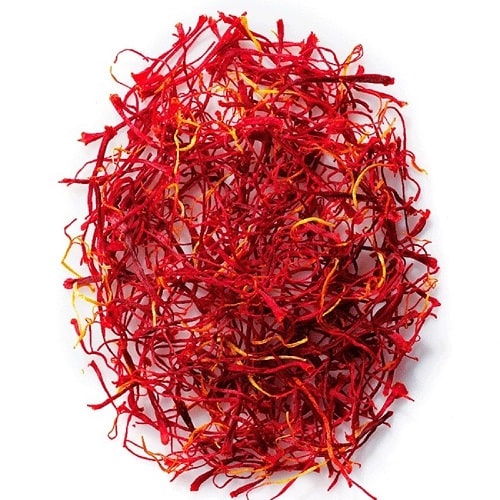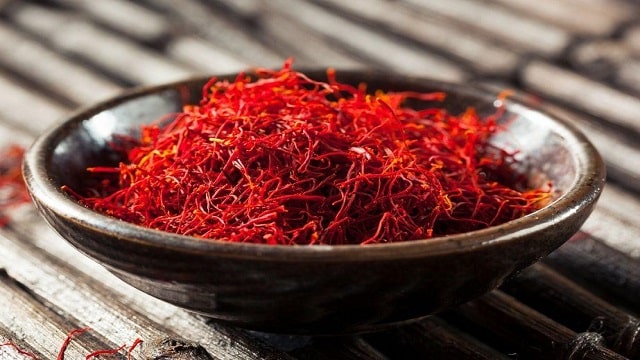We discover everything about saffron, considered the most expensive spice in the world and one of the star products of Castilla-La Mancha. Indispensable in cooking and infallible in any rice dish. Rice and seafood enhanced by saffron. Antidepressant and antioxidant effects that accompany its consumption and a thousand-year-old history that made these red threads appear even in the bed of Zeus. All the details about the most expensive spice in the world.
What is saffron and what is it used for?
Saffron is a medicinal spice obtained from the flower of Crocus sativus, colloquially known as the Saffron Rose, and has been used for millennia. Saffron is a sterile plant that is propagated vegetatively from the chromium, the underground bulb, and only thanks to the intervention of man.
Saffron is harvested in October, always at dawn when the flower petals are still closed, to avoid wasting the “red gold”. A few hours later, the flowers are carefully peeled, one by one, the stigmas, which resemble red threads, are separated and they are dehydrated in the oven or on a brazier, arranged in sieves.
The flavour of saffron is a combination of sweet, earthy, and fragrant. Since Roman times it has been used for this virtue as a condiment, but also as a dye, aroma, and medicinal remedy. In the kitchen, it is a classic for paella, other rice dishes, soups, and stews.
Difference between saffron and turmeric
Due to the similarity of their uses, saffron, and turmeric, which is also known as Indian saffron, have been compared on many occasions.
In many recipes, such as the preparation of Italian laminate, it is common to use a little turmeric powder mixed with a pinch of sweet paprika to achieve the hue and earthy taste of saffron. However, saffron comes from the stigmas of the flower of the same name ( Crocus sativus ) while turmeric is obtained from the bulb of the plant ( Curcuma longa ) .
Origin and history of saffron
The origin of saffron is as mysterious as the ultimate reason for its aroma. Hundreds of researchers have spent decades trying to find the answer to where it was born and what molecules are responsible for its particular fragrance.
Since the early 2000s, chemists have known for certain that safranal is one of the key components of saffron’s aroma, but what about its origin? It remains a mystery. Edible saffron could well have been the result of a hybridisation of two wild species or the result of the domestication of the plant in Greece where its presence dates back more than 3,000 years.
There is no doubt about its importance throughout the great civilizations of history. In Ancient Egypt, saffron was used to dye the shrouds of the pharaohs, while Cleopatra relied on its aroma and delicacy to care for her skin. In Greece, it was a divine spice that served as a bed for Zeus and was born from the disenchantment of a beautiful young man called Crocus, who was turned into petals and threads by the hands of Hermes.
The name by which we know it, saffron, is a vestige of the importance that the Arabs had in its cultivation and commercialization around the world. To such an extent that other languages also retain this etymological root: saffron in English or zafferano in Italian.
In ancient Rome, however, it was known as crocus, a Latin name believed to derive from the Sanskrit kumkum, the same root as the word (and condiment) turmeric, which fuelled the cross-use and designations between the two spices. Today, saffron is grown in Iran, Greece, Italy and Spain, which has saffron with Protected Designation of Origin from Castilla la Mancha as one of the most valued in the world.
Types of saffron
Saffron threads can be thinner, shorter, more or less delicate to the palate, and can be presented with different degrees of dehydration. The difference is determined by the origin of the crop.
Spanish saffron

Spanish saffron from La Mancha with Protected Designation of Origin is always sold in strands rather than powder. It has an intense, penetrating aroma, reminiscent of flowers, and long strands that protrude above the pistils. On the palate, it is slightly bitter at first and has a toasted finish.
Italian saffron

In Italy, saffron is essential for Milanese risotto and they have their own crop with a Protected Designation of Origin in Aquila, in the beautiful region of Abruzzo. Although it arrived from Spain, this variety, grown in calcareous soil rich in potassium, produces threads that are somewhat thicker than average and have great colouring power. Unlike Spanish saffron, Italian Aquila saffron is sold both in threads and in powder form.
French saffron

Dark in colour, saffron cultivated in France arrived via the south in the hands of Arab traders. From Provence, it made its way north to the Casseus du Quercy natural park where it was successfully cultivated. Its disappearance was triggered by a series of factors, including international competition, royal decrees, and the difficulty of finding labour in the mid-18th century. Since the early 2000s, French saffron has been revived in Carjac, in the Quercy region, giving rise to thick saffron threads and an annual festival dedicated to its use and promotion.
Saffron from Iran

Iran is the largest exporter of saffron, its thick threads representing up to 90% of the saffron sold worldwide, although it is not considered the most aromatic. It is extracted mechanically and not just manually, unlike in Spain, and its colour is less vivid and red.
Properties and benefits of saffron
Saffron is rich in carotenoids and terpenes, including those derived from zeaxanthin, pyrocrocin, and safranal, which are also responsible for its flavour and aroma. The areas on which it acts are so wide that it is not surprising that it has historically been considered a medicinal spice. It has antidepressant effects, is able to reduce anxiety, and is a powerful antioxidant.
Antidepressant
Crocin is a type of carotenoid found in saffron that has been studied extensively for its many health benefits. One of the most significant discoveries was its potential role as an antidepressant. It works by preventing the reuptake of serotonin, which allows a greater amount of the happiness neurotransmitter to be available. Its effects have been compared in several studies to those of fluoxetine, although the biggest challenge with crocin is to increase its absorption rate.
Take care of your mental health and improve your memory
Crocin also has anti-inflammatory and antioxidant action. Among its particularities is its ability to cross the blood-brain barrier, which allows it to carry out its protective activity in neuronal tissue. This function contributes to the improvement of cognitive abilities and acts as a protector against depression, anxiety, and schizophrenia. On the other hand, it promotes the function of the protein called brain-derived neurotrophic factor, which collaborates in neuronal signaling and contributes to a good memory.
Reduces symptoms of premenstrual syndrome
Premenstrual syndrome is a set of emotional and physical symptoms that appear between five and ten days before the period. One of the most acute variants of this syndrome is menstrual dysphoric disorder, which involves severe depression and anxiety during these days of the cycle. Thanks to the antidepressant effects of crocin, saffron is helpful in alleviating the symptoms.
Antioxidant and anti-inflammatory
Safranal is the compound responsible for the aroma of saffron and has a relevant protective role. It is able to reduce the activity of pro-inflammatory compounds. It also reduces oxidative stress, taking care of the good health of our cells, and also reinforces the anti-depressant property of saffron.
Contraindications of saffron
Saffron is contraindicated for pregnant and lactating women. It is important that people with serotonergic pathologies consult with their doctor before taking any type of capsule or extract since it could interfere with the treatment or worsen their symptoms.
Except in these cases, the consumption dose does not present any danger and we should only remain alert when it exceeds ten grams, something very unlikely, but which is related to toxic effects and internal bleeding that could lead to death.
Recipes with saffron and its uses in the kitchen
Saffron is written with an A for rice recipes. Rabbit and saffron broth rice or Valencian paella. Creamy fish rice dishes such as senyoret rice or Murcian caldero rice are inseparable allies of saffron. Near the sea, seafood cream with saffron follows. Garlic soup with saffron is born among vegetables, and when we question legumes, saffron appears to elevate beans with clams, chickpea stew, or potatoes with squid.
Crossing borders, saffron flavours Milanese risotto, galinhada (Brazilian chicken with rice), Moroccan harira sauce, or the aromatic chicken tagine with a few strands of saffron. Not only does it make its way into savoury recipes from other cuisines, but it also enhances sweet dishes such as rice pudding and raises the colour of marzipan.
Why saffron is known as “red gold” and what is its price
At the time of writing these lines, the price of a kg of saffron from La Mancha was around €4,000. This is not the highest price that these strands, considered red gold precisely because of their high value on the market, have seen.
The reason why saffron is so expensive is due to the characteristics of its cultivation and the low productivity of its flowers. Only three stigmas are obtained from each flower, which give rise to the spice. To obtain a single gram of saffron, we need between 150 and 170 flowers. They are harvested in October and the type of soil and rainfall are decisive in obtaining the greatest quantity and quality of saffron.
Manual harvesting, waiting until dawn to pick the flowers and the need for a hectare of land to obtain just 2 kg of saffron make the process more expensive and result in the most expensive spice in the world.
